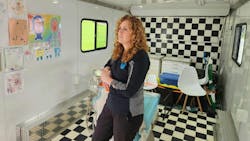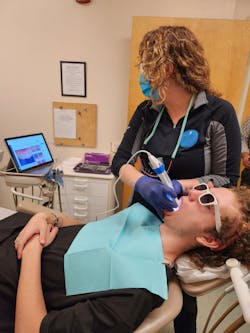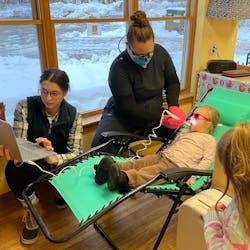How intraoral cameras and teledentistry educate patients, build trust, and improve oral health
I always wanted to have a mobile dental clinic. In 2020, at the height of COVID-19, I started Mainely Teeth out of a mobile trailer and provided school-based oral care in Maine. Although starting a nonprofit dental program in the middle of a pandemic may have seemed unwise, the need for oral care among schoolchildren quadrupled during this time. I was filling a growing need!
In three years, our small but mighty nonprofit has grown exponentially. Our scope of care includes all uninsured and underinsured residents of the state with a focus on pediatric and special needs patients.
What’s more, we currently cover a lot of ground—12 of the 16 counties in Maine. We partner with other organizations throughout the state to use their brick-and-mortar locations and provide oral care services in more than 80 locations. Part of the success of Mainely Teeth can be attributed to our investment in what I consider to be core technologies—intraoral cameras and teledentistry.
You may also want to read:
5 ways teledentistry can improve the oral health system
Is your intraoral camera a diagnostic tool or a marketing tool?
The impact of intraoral cameras
Intraoral cameras are unbeatable for educating patients, building patient trust, and improving oral health outcomes. We can provide this level of quality patient care with MouthWatch cameras because they also help us check all the right boxes for our nonprofit operations, including price, performance, and support.
When patients can see images of what’s occurring in their mouth, they understand their diagnosis and realize the urgency of preventive or interventional treatment. Armed with intraoral photos, I can tell a patient, “This is really happening in your mouth. You have a severe condition that needs to be treated.”
Building trust is especially important to the many patients we see who grew up in cyclical poverty or in areas where access to dentistry is a challenge. Many have never had dental care and the cycle continues with their own children who are unable to get to a dentist for similar reasons.
For many of our patients, dentistry is associated with fear and anxiety since they may have sought only emergency dental care for severe pain. Going to the dentist for these patients has never been a positive experience. However, when we show them intraoral photos and take the time to review the findings with them, it’s a game-changing experience. They’re more likely to feel that we care about them and sincerely want to help them take control of their oral health.
The intraoral camera is a double-edged sword of patient education and building trust. It can involve life and death factors if we refer the patient to an oral surgeon, for example, if we detect a suspicious lesion. Seeing is believing and we want patients to keep that appointment!
What about the kids?
Kids love it when we share intraoral photos and videos with them. They love seeing their teeth, and this helps them become excited about their oral health care. I can't even tell you how many times I've taken pictures of kids’ teeth and they want to count them.
We're using intraoral photos and videos to help kids love and want to take care of their teeth. As someone who’s passionate about prevention and dreams of a world where there’s no more decay and dental disease, intraoral cameras give me hope because these kids can see the difference for themselves and they’re doing better. I’m convinced that we will be more successful in helping this generation understand the importance of oral health.
Introducing teledentistry and virtual care
In 2018, the Children’s Oral Health Network of Maine asked if I would be interested in partnering with them to develop and roll out a new teledentistry pilot for the state. My answer was a resounding yes! I had a pent-up interest in teledentistry because although my mobile program was providing some school-based oral health services such as fluoride varnish clinics and screenings, there was so much more access to care that we needed to provide. We're a very rural state with many poor residents, and many people get left behind.
I believe teledentistry is the future. When the opportunity to be the first to provide virtual care in the state was presented to me, I was thrilled. We got to work developing a pilot project for Maine that launched in 2019, and we’re now in the final phase. When we began, we needed a teledentistry platform that would help us collect patient data and develop a workflow that could be replicated and used across the state.
Teledentistry wasn’t legal in Maine until October 2022, so when we started, we had to demonstrate to the state of Maine, the Maine Dental Board, and the state legislature that teledentistry was needed and it could work with the proper tools.
But what were the proper tools? I evaluated several teledentistry solutions and selected TeleDent by MouthWatch. The number one reason for my selection was that I found TeleDent to be very user-friendly. I could tell it was designed by software developers working closely with practicing clinicians. I also liked that I could log in from anywhere.
I sometimes see 15 to 20 kids a day and I need to be able to scan their paperwork, chart, take a photo, take a video, and assign a tooth task. TeleDent enables me to do that and easily connect with parents and providers in live (synchronous) or recorded (asynchronous) modes.
Breaking down barriers to dental care with intraoral cameras and teledentistry
At Mainely Teeth, we use an intraoral camera on every patient. It doesn't matter if they're in our office, in our mobile clinic, or in a nursing home. Intraoral camera use and capturing images and video are now fully integrated into our workflow and part of our standard of care.
The intraoral cameras are not only part of our standard of care, but they’re also the eyes of our teledentistry program. By combining intraoral cameras with teledentistry, we're able to manage and monitor patient care without the patient having to step foot into a brick-and-mortar clinic.
We're essentially breaking down the four walls of a dental office. By doing so, we’re also breaking down barriers to care for families by meeting them where they are. We recently led a pilot project at a veterans’ home in Northern Maine. Many of the residents can't easily leave the facility for dental care, but thanks to intraoral cameras and teledentistry, we’re meeting them where they are, conducting a preliminary exam, and referring them to an off-site clinic when necessary.
Thanks to the use of intraoral cameras and teledentistry, many more patients are undergoing exams, whereas in the past they would not have due to health or travel restrictions. These technologies have helped us maintain our standard of patient care despite staffing shortages, and we can cover a lot of ground with fewer staff members.
We have people come in with massive infections who have never had dental care and need immediate help, need a tooth pulled, or need dentures, and they can't afford to get their teeth cleaned anywhere else. I believe this is just the start of the teledentistry era. It's going to be fun to see where it is in 10 to 15 years.
Amber Lombardi, IPDH, is a graduate of the University of New England, a master’s in public health candidate, and a member of ADHA. She started Mainely Teeth to bring community access to quality dental care. She wants to break down the barriers to oral health care. Amber’s greatest hope is that her mobile clinic will make care more accessible for those in need. She’s been providing care across Maine for more than five years.
Editor's note: This article appeared in the November 2023 print edition of Dental Economics magazine. Dentists in North America are eligible for a complimentary print subscription. Sign up here.
About the Author

Amber Lombardi, IPDH
Amber Lombardi, IPDH, is a graduate of the University of New England, a master’s in public health candidate, and a member of ADHA. She started Mainely Teeth to bring community access to quality dental care. She wants to break down the barriers to oral health care. Amber’s greatest hope is that her mobile clinic will make care more accessible for those in need. She’s been providing care across Maine for more than five years.



